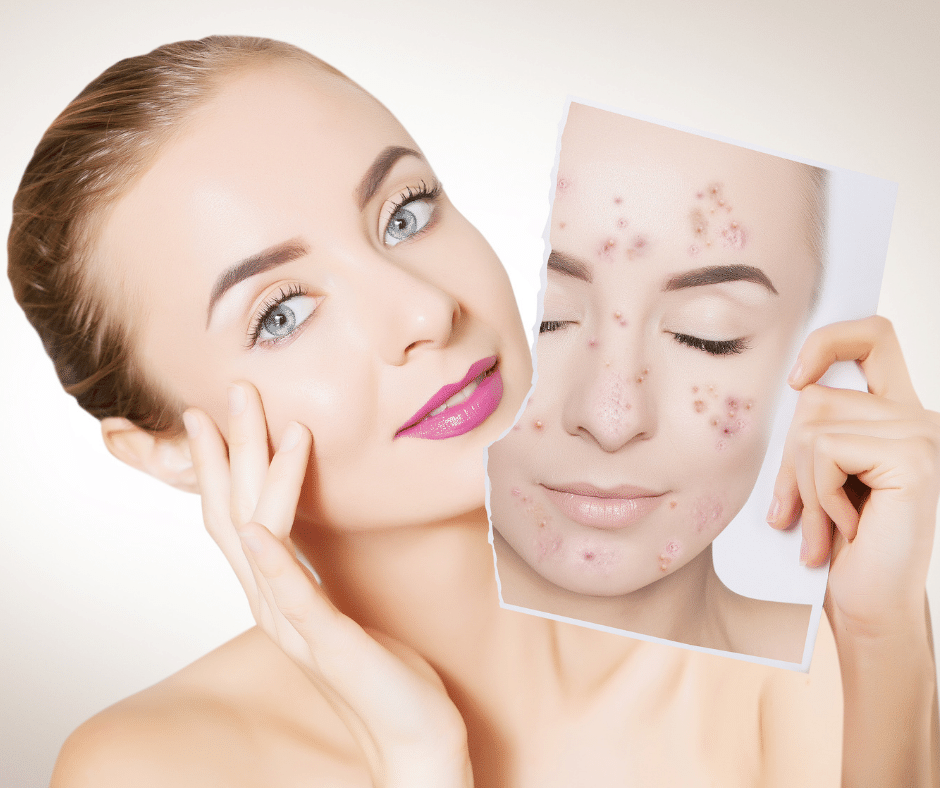Acne: The Basics, An Estheticians Review
Informational guide about acne, causes, triggers and factors that can contribute to acne in the skin from an esthetician's point of view

Do you wake up every morning to a new zit? Are you constantly looking for answers on how to get rid of your acne? If you answered yes to both, this blog post is for you! We'll be discussing everything from what acne is and what causes it to how you can get rid of it. Keep reading to find out more!

What Is Acne?
At the most basic level, acne is a skin condition that occurs when your hair follicles become plugged with oil and dead skin cells. It's estimated that millions of people experience acne. If you suffer from acne you're not alone.
Acne often shows up as whiteheads, blackheads, or pimples. In severe cases, acne can lead to widespread inflammation and scarring. Acne is likely caused by multiple factors, including hormones and inflammation. While we don't know exactly how the mechanisms work together to bring on acne breakouts or what starts them off, or if it starts with an inflammatory condition like redness, soreness, or scales. These can often occur where small pimples form (a process called P Wave pulling). Research is discovering certain triggers or co-existing factors.
Common Acne Contributors
Hormones
Hormones are chemicals that control many processes in the body, including skin development. When there is an imbalance of these hormones it can lead to problems with your hair and teeth as well as acne breakouts on the face, back or other parts of the body!
Inflammation
Acne is a disease that can be partly attributed to inflammation. Inflammation occurs when your body's immune system mistakes oil for bacteria and starts attacking it, leaving behind open pores which are prone to bacteria and can clog up with dirt or dead skin cells. This process doesn't just happen on acneic skin - anyone who has experienced an outbreak may have noticed their face becoming redder than usual while also sporting bumps from inflamed skin in certain areas where blackheads usually form.
Hygiene
One contributor to acne is hygiene. Because dead skin cells are continuously being shed we need to make efforts to keep the facial area clean with the use of cleansing agents and daily wash habits. Additionally, clean bedding can contribute. At least weekly washing of bedding is essential for those who are prone to acne. Depending on the type of acne and grade you have, the right cleanser can help play a role in controlling acne. After sweating or working out the skin should be cleaned to keep it free of bacteria and sweat which cause breakouts.
Stress
Stress is a natural occurrence in life. Everyone has stress. Some experience more than others. Stress affects your body in multiple ways. Acne patients often experience stress as well, but the link between them isn't fully understood.
One possible explanation is that it might lead to an overactive sebaceous gland. This in turn causes inflammation around your pores and causes the hair follicles with dead skin cells and sebum residue to become clogged pores.
Vitamin deficiency
Our dermal layer is responsible for supplying nutrients to the skin, nails, and hair. Supplying our bodies with proper nutrients, and water intake to flush out toxins and create a balanced microflora improves acne. Your skin is in constant attack from the environment with pollution, UV damage, and other factors that it constantly battles to stay in balance and to protect from outside environmental stressors like dust, and dirt.
Diet
There is a connection between the gut and skin axis. The gut and skin microbiome has a huge impact on your health and acne. The altered composition of these communities can lead to disorders such as atopic dermatitis, psoriasis, acne vulgaris, dandruff, or even cancer! The gut microbiome regulates the immune system and is responsible for the body's homeostasis. It communicates through tissues by way of signals and other means with organs to cause many diseases or prevent many diseases including those with your skin. Research shows a correlation between gut health and rosacea, acne, dermatitis, dandruff, psoriasis, and even wound healing.
Allergens
While it is not believed that having an allergy is causal to the formation of acne, evidence suggests if you already have acne, allergens can trigger more acne breakouts.
Food Allergies and Acne in Adults
If you have asthma, eczema, or another type of skin condition that affects your skin there may be a link to acne as well as other skin conditions and food.
A food allergy is your immune system overreacting to specific proteins in particular foods. Your body can receive the food as a foreign invader and release histamine in response. An example would be hives around your mouth or ears. About 90% of food allergies are related to eggs, fish, milk, peanuts, wheat, soy, tree nuts, and shellfish according to the Food, Allergy and Anaphylaxis Network 3. In adults, food allergies can contribute to acne breakouts.
Certain Medications
Some medications can increase acne breakouts. It is beneficial to talk with your doctor if you are on medications and notice a change in your skin with increased acne.
Our Integumentary System
A Complex Organ
The human skin is a complex organ that contains billions of cells. It is the largest organ of your body. It weighs roughly about 15% of your body weight. The skin is equipped with many bodily systems that either work in harmony or disharmony with one another. The integumentary system is composed of the skin, hair, and nails.
It works with the circulatory system, the skeletal system, the nervous system, the immune system, and the respiratory system.
The skin's complex system is the first line of defense against bacteria, viruses, external pathogens, injury, and UV rays from the sun. It covers and protects all of your other body systems. Your skin regulates your body temperature through glands and nerves in your skin. It allows you to feel heat and cold and synthesizes the production of vitamin D.
Oil secretion occurs in the sebaceous glands located within the dermal layers of our skin. The skin is composed of a top layer called the Epidermis, the middle layer called the Dermis, and the Hypodermis (adipose tissue) which is made of fats and connective tissues and sits just above your muscles. The fat behaves like a shock absorber while supporting both blood vessels and nerve endings.
The skin has its unique network of cells that signal and communicate with one another to function properly. The outer layer or surface layer contains dead skin cells. This is what you would refer see as your skin. The epidermal layer has 6 layers contained within it. These 6 layers go through a process of transformation with the bottom layer starting out as moist, cubical living cells and within approximately a month they dry up into dead skin cells (the surface layer of our skin). The bottom layer of the epidermis is connected to our dermis referred to as the dermal-epidermal junction (DEJ).
The middle layer of skin, the dermal layer, the thickest layer of your skin, is composed of hair follicles, sebaceous glands, and sweat gland ducts. This is where the oil production occurs. Our blood vessels, lymphatic vessels, and sensory nerve endings are located in this vast network of connective tissues. Sebum is excreted from the dermal layer up to the epidermal layer. During this process is where acne forms.
Acne occurs from a combination of many factors, imbalances, inflammatory responses, and dead skin cells that clog pores, bacteria forms and creates a pustule or papule (acne). The sebaceous glands are responsible for producing oil from sweat combined with bacteria on the surface and pores in your hair follicles where excess dirt can enter through the hair follicle openings (also known as a "pore"). These combine to give rise to this inflammatory response when the follicle becomes plugged by clogging hairs which leads us to acne breakouts!
How Can I Get Rid Of My Acne?
There are many different treatments for acne, but finding the right one for you depends on your skin type and the severity of your acne. Some common treatments include probiotics, over-the-counter creams, gels, homeopathic remedies, prescription medication, chemical peels, laser therapy, etc. Getting to the root of what is triggering your acne is often the first start. Talking with an esthetician and skin treatment plans is often a great first start.
Words of Wisdom
Acne doesn't go away on its own. It often takes a full-pronged approach with a treatment plan and homework (home treatment and care) to effect change and long-term results.
Chemical Peels are an advanced mechanism of exfoliation. These can help acne through exfoliation by balancing sebum production and balancing the skin microbiome.
We do not recommend using peels at home. These can damage your skin, make your acne worse, and cause third-degree burns. They can also cause permanent scarring if you do not have proper training. Schedule these services with trained professionals.
Final Thoughts
Acne is a common skin condition that can be frustrating to deal with. It can affect your mental health and self-esteem. However, by understanding what causes it and knowing what treatments are available, you can take steps to manage your acne and improve your self-esteem and your complexion!
References
De Pessemier, Britta et al. “Gut-Skin Axis: Current Knowledge of the Interrelationship between Microbial Dysbiosis and Skin Conditions.” Microorganisms vol. 9,2 353. 11 Feb. 2021, doi:10.3390/microorganisms9020353
Goletz, Stephanie et al. “Structural proteins of the dermal-epidermal junction targeted by autoantibodies in pemphigoid diseases.” Experimental dermatology vol. 26,12 (2017): 1154-1162. doi:10.1111/exd.13446
Roig-Rosello, Eva, and Patricia Rousselle. “The Human Epidermal Basement Membrane: A Shaped and Cell Instructive Platform That Aging Slowly Alters.” Biomolecules vol. 10,12 1607. 27 Nov. 2020, doi:10.3390/biom10121607

